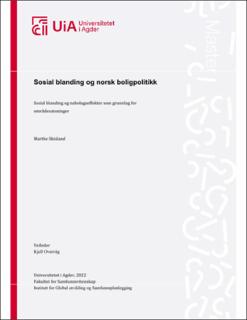| dc.description.abstract | Social mix has increasingly been seen as a goal to combat poverty and socioeconomic
segregation in cities, especially in recent western contexts. The aim for this thesis is to explore
in what way Norwegian uses social mix-thinking in housing policy, and what it does to
prevent the potential negative effects of this approach. In the theoretical exposition I examine
some of the principles of social mix thinking in policy, its fundamental assumptions, and its
central criticisms. With this basis this thesis looks at how Norwegian housing policy relate to
these theories and assumptions, both implicitly and explicitly. This thesis will focus especially
on social mix as a perceived way to combat poverty related issues associated with living in
poor neighbourhoods. The basis for the analysis is a document study of official documents
related to Norwegian housing policy, and official exposition of living in cites.
Although there are positive effects related to living in well-developed environments, the effect
of neighbourhood effects may be exaggerated, and there is little empirical evidence that
varying the socioeconomic composition in a neighbourhood significantly increases prosperity
with residents with low-income or are in other ways disadvantaged. Displacement of existing
communities are one of the most central challenges in relation to area-specific improvements
– and one of the factors that contributes to “social initiatives” can work against their purpose. | |
